
Key Highlights
Here is a quick look at the main points about the kantharos:
- The kantharos is a distinctive drinking vessel from ancient Greece, known for its deep bowl and two high-swinging handles.
- It is strongly associated with Dionysos, the Greek god of wine, and often appears in artwork featuring him and his followers.
- While used for drinking wine, the kantharos also played a significant part in ritual use, symbolizing rebirth and immortality.
- The design of this drinking vessel dates back to the 8th century B.C.E.
- You can find examples made from terracotta, gold, and silver in museum collections worldwide.
When you look at ancient Greek vases, there are many shapes you will see. From the amphora Greek vase to the lekythos and oinochoe. One of the most well-known for wine in ancient Greek life is the kantharos. This type of cup was more than just something people used to drink. It had a strong meaning and symbol for people of that time. Its shape is tied to the god of wine. This makes it a key part of Greek vases and the history of ancient Greek culture. Now, let’s find out more about this vessel and what it meant to the people back then.
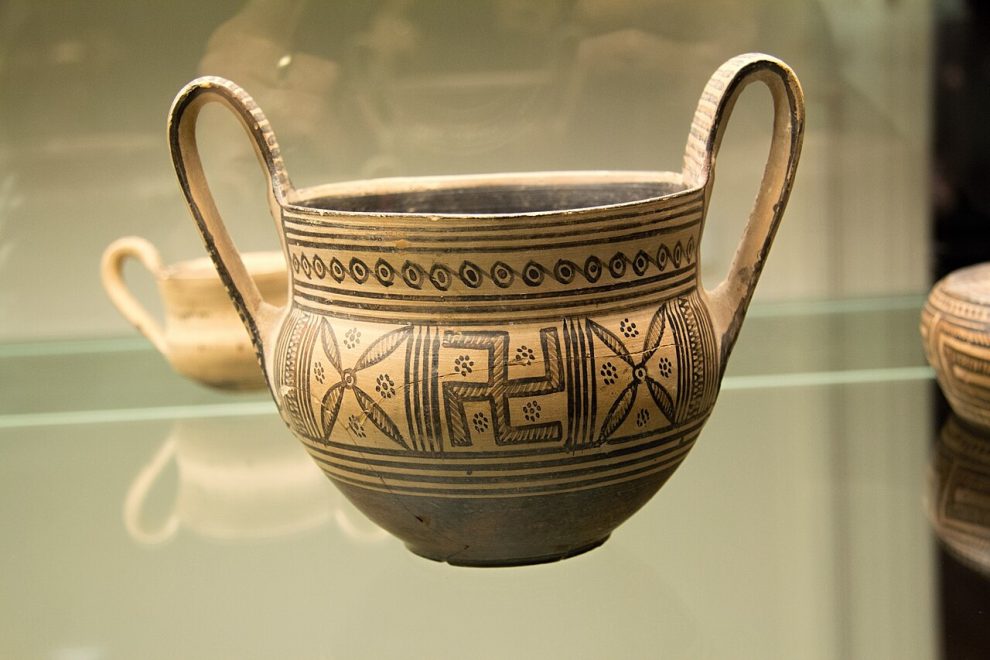
Image by: Zde
Kantharos Meaning: Origins and Design
The kantharos is a drinking vessel from ancient Greece. People first made this vessel as far back as the 8th century B.C.E. The name kantharos has an interesting story behind it. This pottery is easy to spot because its shape is different from other ancient Greek pots. The way it looked was not just for show. Its shape had a link with its use in Greek culture.
When you learn about the shape and where the kantharos comes from, you get why it was so important. The design of this vessel did change over time. But the main parts of the kantharos stayed the same. This kept it tied to the old traditions of Greece. The kantharos is a great example of ancient Greek pottery, showing how people in ancient Greece valued both form and meaning in what they made and used.
What is a Greek Kantharos?
A kantharos is a kind of cup from ancient Greece. It has a deep bowl, a tall stem, and two big handles that stand out. The shape started in the central part of Greece in a place called Boeotia. Later, people in Italy, like the Etruscans, began to make their own kantharos cups.
The word kantharos is linked to how the cup was used and the traditions around it. The god of wine, Dionysos, is often shown with a kantharos in old Greek vases. This shows the strong tie between the cup, wine, and the idea of celebration in ancient Greek life.
The kantharos was more than just a cup. It was tied to drinking, rituals, and what people thought about the god Dionysos and social gatherings in ancient Greece. The design and the name of this cup are part of Greek history and customs.
Features That Separate Kantharos from Other Drinking Cups
How can you tell if a cup is a kantharos when you look at Greek pottery? The shape makes this drinking vessel stand out. Other cups, like the kylix, are not as tall and are more flat.
You will find these things in a kantharos:
- A deep bowl that can hold a good amount of wine.
- A tall foot that lifts the cup up.
- Two big handles that loop and go up past the rim.
This style is known as Type A. The look of this Greek drinking vessel is part of what makes it easy to spot. It is more than good to look at; it shows how the kantharos was used in social times and rituals. In artwork, you often see it with Dionysos, his followers, the satyrs, and that link makes the cup an important attribute of Dionysus. You know what it is for by how it looks, and you can see it was a part of art and life for the people back then.
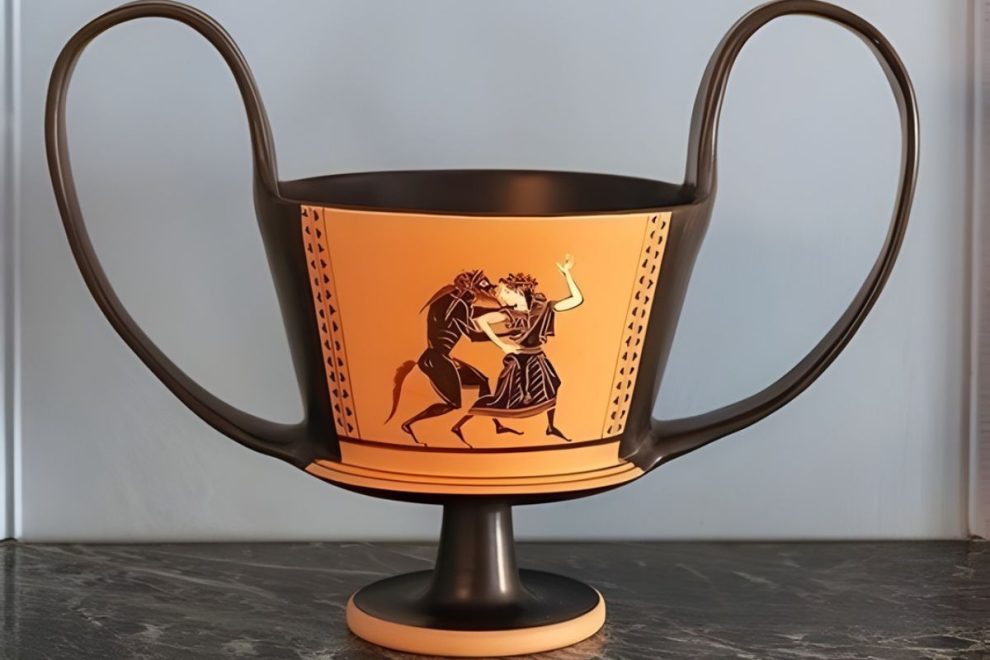
Materials and Decorative Styles of a Kantharos Vase
Kantharoi were made from many different things. This shows how important they were in ancient greece, and that they were used in different ways. The pottery from Greece is known for being beautiful. Many people used the kantharos to show off their art with different designs.
The makers chose materials like simple clay or even gold, depending on what the vessel was for. The way they decorated these pots could be very simple or have fine pictures that told a story. Now, let’s take a closer look at the materials and art styles they used for ancient greece pottery.
Materials Used for Kantharos Greek Pottery
The most frequent material used for Greek pottery, including the kantharos, was clay. Potters shaped terracotta on a potter’s wheel to create the vessel’s signature form. These clay cups were accessible and widely used. However, kantharoi were also made from more valuable materials for meaningful purposes.
Archaeological finds include kantharoi made from precious metals like gold and silver. A silver coin from Asia Minor dating to the late 5th century B.C.E. even depicts Dionysos with a kantharos. This shows the shape was replicated in different media. The use of these materials suggests that some kantharoi were high-status items or important votive offerings.
| Material | Common Use/Context | Example Location |
|---|---|---|
| Terracotta | Everyday drinking, ritual offerings, funerary gifts | Attica, Apulia |
| Gold | High-status display, elite use, potential votives | Mycenae |
| Silver | High-status items, depicted on coinage | Asia Minor |
Motifs of a Kantharos Vase
The decoration found on a kantharos could be plain or very fancy. Many of these vases have a black gloss. This made the vase look smooth and shiny. Some artists liked to add little extra touches to these glazed pieces. They might use thin lines cut into the gloss to show the orange clay underneath. This way, the decoration looked simple but nice.
Other kantharoi showed detailed vase painting with pictures and scenes. These often showed stories from myths. You could see Dionysos, satyrs, and maenads. Many vessels found in southern Italy had words written on them. One was dedicated “to Aphrodite.”
Common decorative elements included:
- Solid black gloss decoration.
- Bands cut into the stem or body.
- Scenes showing mythology or parties.
- Written words that dedicate the vessel.
Vase painting and decoration from Italy and southern Italy used many styles. These elements show us what people liked to see and remember. The artists used different ways to make each kantharos distinctive, often adding details about Dionysos, satyrs, and classic myths.
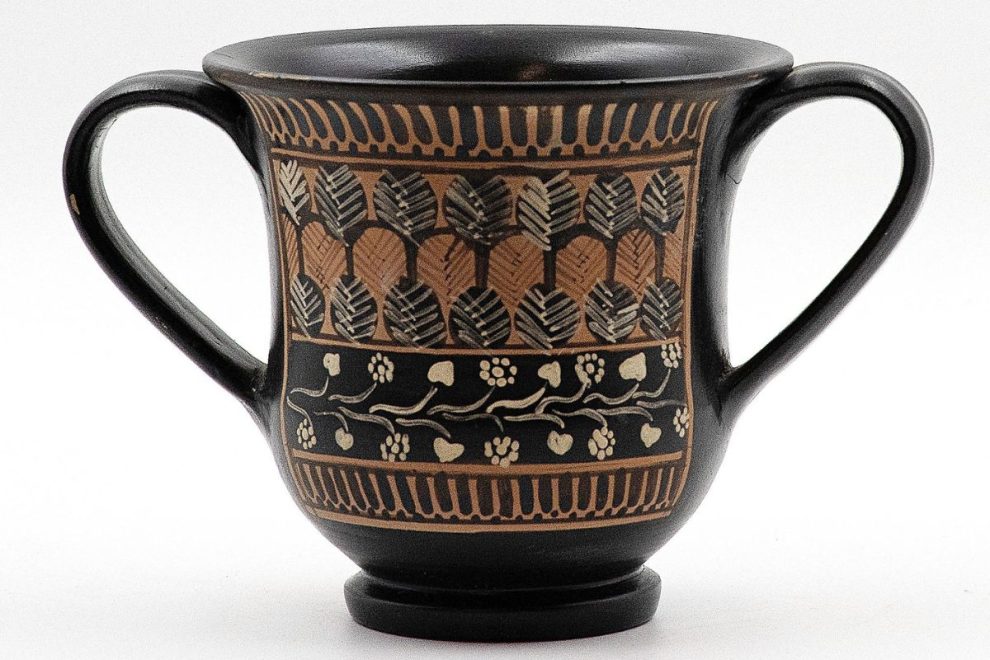
Kantharos in Ancient Greek Culture
In ancient Greece, people often used the kantharos, a drinking vessel tied to Dionysos, the god of wine, during different cultural rituals. This pottery item was shaped on the potter’s wheel and stood out because of its detailed decorative elements. These designs showed the social habits and beliefs of the time. At gatherings, the kantharos was more than just a cup to drink from. It showed celebration and brought people together. The vessel would often show scenes from mythology, like satyrs and dancers. This drinking vessel was important not just for its use. It helped people understand the way of life in Greece. You could see its importance in many places, like Southern Italy and Asia Minor, too, with related influences traced in Corinthian pottery and Cypriot pottery.
Role of the Kantharos in Symposia
Scenes of symposia often show kantharoi, but some people say the cup was not just used for drinking at banquets. The kantharos was more than that. It was a strong symbol in social events and the vessel was a known attribute of Dionysus, the wine god. People believed that holding the kantharos could help them feel close to Dionysus.
The kantharos was tied to change and new beginnings. Scholar George W. Elderkin said wine could help people let go of worries, lift their spirit, and make them feel god-like for a moment. Using the kantharos for this drink made the vessel important to those moments. The cup was also seen in art around deaths and funerals. It might have been used for pouring drinks to honor people who died, and could stand for rebirth or living forever.
Its roles often included:
- The kantharos was a symbol of Dionysian worship.
- It was used as a vessel for ritual libations.
- It was an object that stood for rebirth or immortality.
- The kantharos was a prop in funerary cult practices.
This vessel was a clear attribute of Dionysus and held deep meaning far beyond just being a drinking cup.
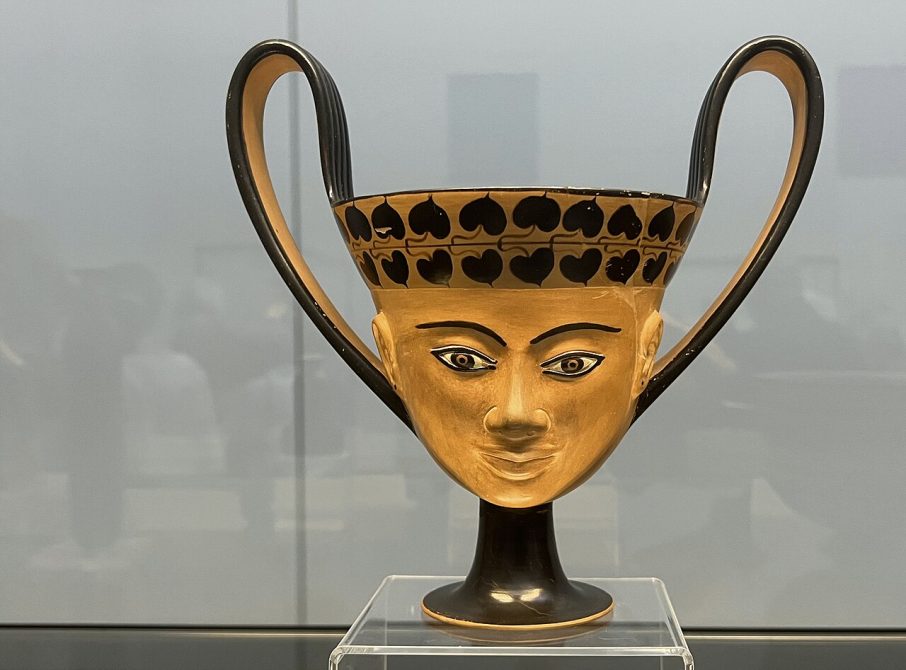
Image by: Burkhard Mücke
Kantharos in Museum Collections
You don’t need to be an archaeologist to see a kantharos today. Many of these artwork pieces be in museum collections all over the world. The museums keep the vessels safe and share info about their provenance. This helps us connect to the old world.
Some museums share public domain images and detailed online catalogs. You can use these to look at the objects at home. By seeing these saved kantharoi, people get to know about their careful work and what they mean to those cultures.
Famous Greek Kantharos Pieces
You can find stunning examples of the kantharos in major museums. These pieces come from different regions, like Greece and Italy, and are made from various materials. The Met collection, for example, allows an international community of students and researchers to access its records online.
Each piece tells a part of the kantharos story, from its early Mycenaean forms in gold to the classic black-gloss pottery of Athens. Below are a few notable examples you can view in person or online.
| Museum Collection | Description | Material | Date |
|---|---|---|---|
| The Met Fifth Avenue | Gold kantharos from the Mycenaean period | Gold | ca. 1550–1500 B.C.E. |
| Art Institute of Chicago | Kantharos with an inscription to Aphrodite, from Southern Italy | Terracotta | 310–280 B.C.E. |
| CU Art Museum | Attic black-gloss kantharos with incised bands | Terracotta | 4th century B.C.E. |
Identifying a Kantharos
If you are seeing Greek pottery and want to find the kantharos, look at its shape. Many cups have two handles, but the kantharos’s handles are tall and stand up in an elegant way.
First, focus on the shape. It has a deep bowl, not a wide and flat one. Check the handles next. Do these handles go up above the edge of the cup? That is a big clue. Also, see if there is a tall stem that holds up the bowl.
When you use a museum’s website, the object record can help you make sure you have found the right cup. You could use the tab key and arrow keys to go over the details. These are the things you want to see:
- Two high-swinging handles.
- A deep bowl.
- A tall, stemmed foot.
- Any inscription or decoration connected to Dionysos.
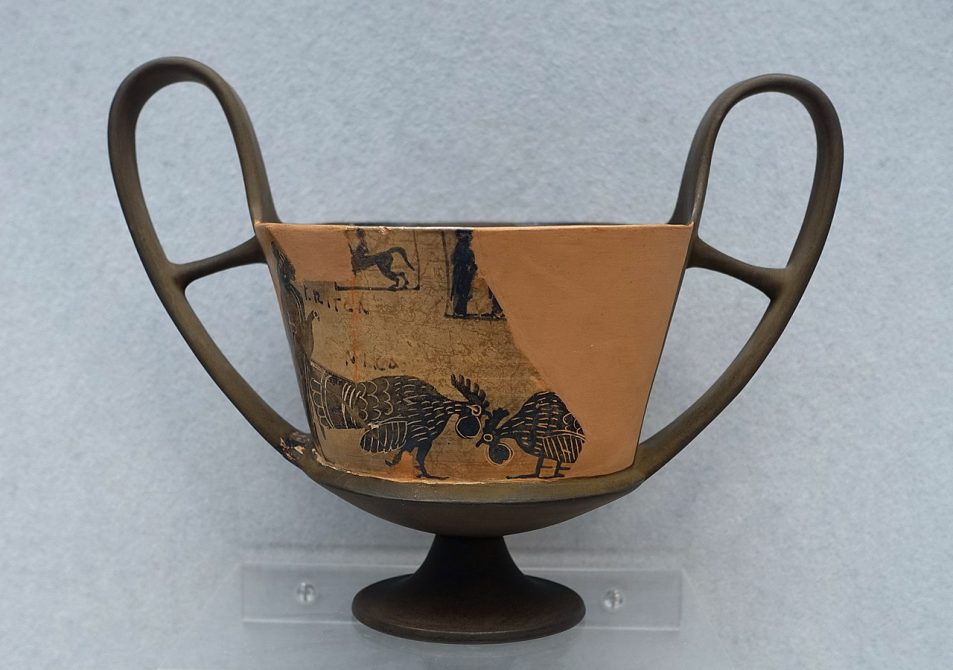
Image by: Daderot
Parting Thoughts
The kantharos is more than just a cup from ancient Greece. It sits alongside icons like the Dipylon Krater within ancient Greek vase history. It stands for the social life, deep beliefs, and beautiful art from that time. Through the work of museums and the use of open access data, these pieces from Greece are easier for us to find now. For all the creators and dreamers, you can use a virtual exhibition queue to see these collections up close online. You might find new ideas in their classic shape and history.
